Independent State of Papua New Guinea
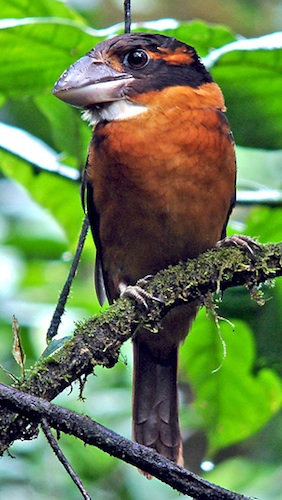
Papua New Guinea is a country in Oceania that comprises the eastern half of the island of New Guinea and offshore islands in Melanesia, a region of the southwestern Pacific Ocean north of Australia. It has a land border with Indonesia to the west and neighbours Australia to the south and the Solomon Islands to the east. Its capital, on its southern coast, is Port Moresby. The country is the world’s third largest island country, with an area of over 462,000 km2 (178,700 square miles).It has a government estimated population of about 10,600,000 people with around 420,000 living in the capital.
There are 840 known languages of Papua New Guinea (including English), making it the most linguistically diverse country in the world. It is also one of the most rural countries, with little more than 13% of its population living in urban centres. Most of its people live in customary communities. Despite government estimates it was reported in December 2022 that its population was in fact closer to 17 million. Papua New Guinea is the most populous Pacific island country. About 40% of the population are subsistence farmers, living relatively independently of the cash economy. Their traditional social groupings are explicitly acknowledged by the Papua New Guinea Constitution, which expresses the wish for “traditional villages and communities to remain as viable units of Papua New Guinean society” and protects their continuing importance to local and national community life.
The country has an exclusive economic zone of 2,402,288 km2 (927,529 square miles). The mainland of the country is the eastern half of New Guinea island, where the largest towns are also located, including Port Moresby and Lae; other major islands within Papua New Guinea include New Ireland, New Britain, Manus and Bougainville.
Located north of the Australian mainland, the country’s geography is diverse and, in places, extremely rugged. A spine of mountains, the New Guinea Highlands, runs the length of the island of New Guinea, forming a populous highlands region mostly covered with tropical rainforest, and the long Papuan Peninsula, known as the ‘Bird’s Tail’.
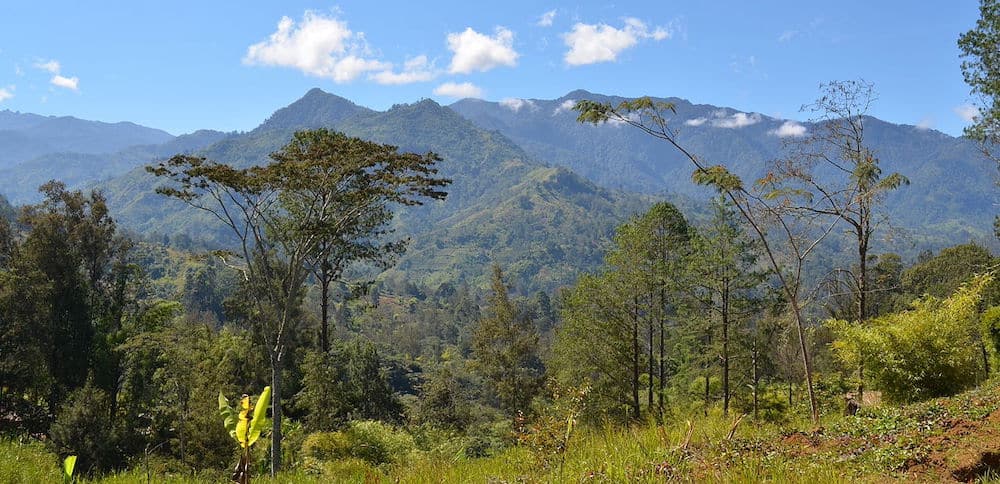
Highlands – ©eGuide Travel, CC BY 2.0 via Wikimedia Commons
Dense rainforests can be found in the lowland and coastal areas as well as very large wetland areas surrounding the Sepik and Fly rivers. This terrain has made it difficult for the country to develop transportation infrastructure, so air travel is often the most efficient and reliable means of transportation. The highest peak is Mount Wilhelm at 14,793 feet. Papua New Guinea is surrounded by coral reefs which are under close watch, in the interests of preservation. Papua New Guinea’s largest rivers are in New Guinea and include Sepik, Ramu, Markham, Musa, Purari, Kikori, Turama, Wawoi and Fly.
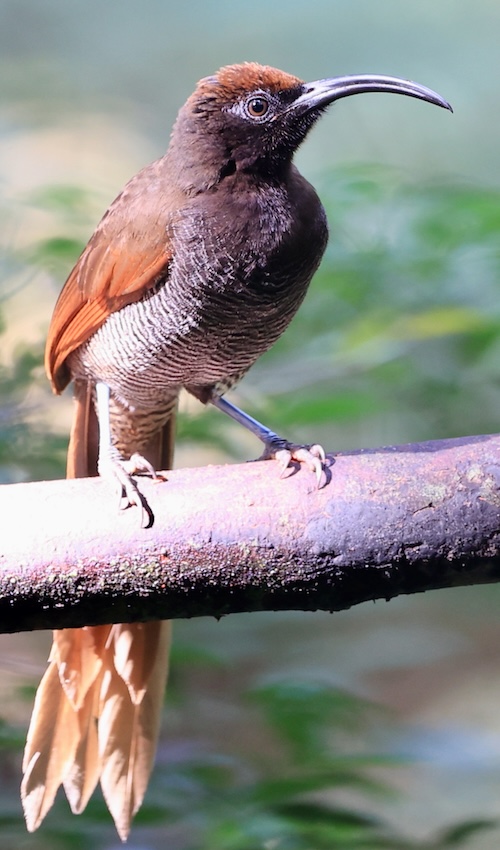
Black Sicklebill Epimachus fastosus – ©Bird-Photo-Tours ASIA
The climate on the island is essentially tropical, but it varies by region. The maximum mean temperature in the lowlands is 30 to 32 °C, and the minimum 23 to 24 °C. In the highlands above 2100 metres, colder conditions prevail and night frosts are common there, while the daytime temperature exceeds 22 °C, regardless of the season.
Birding Papua New Guinea
Many species of birds and mammals found on New Guinea have close genetic links with corresponding species found in Australia. One notable feature in common for the two landmasses is the existence of several species of marsupial mammals, including some kangaroos and possums, which are not found elsewhere. Papua New Guinea is a mega-diverse country and the country is believed to be the home of many undocumented species of plants and animals. It is an incredibly diverse island both in terms of its culture and its avifauna. Lying just beyond the easterly remnants of the Asian continent and Wallace’s line it is in most respects very much Australasian. There are no Barbets, Woodpeckers or Trogons for example and likewise no primates. This isolation has allowed marsupials and many Australasian bird families to flourish. Particularly well represented groups include Pigeons, Parrots, Owlet Nightjars, Kingfishers, Australasian warblers and Fantails, Monarchs, Australasian Robins, Honeyeaters, and of course the Birds of Paradise for which this wonderful archipelago is justly famous.
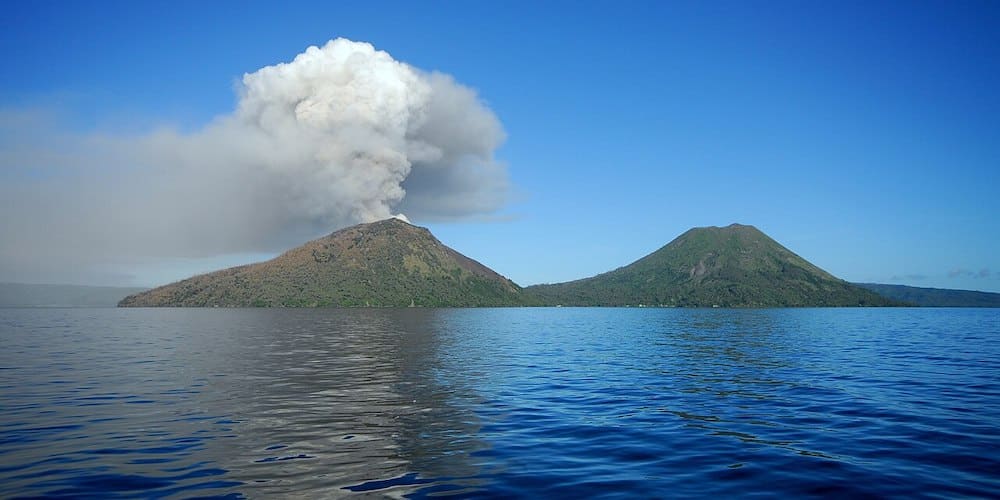
Mounts Turanguna & Kombiu – ©Taro Taylor, CC BY 2.0 via Wikimedia Commons
This geographic isolation, combined with the rugged mountainous interior has also led to an incredible diversification of people and nearly every valley seems to have its own culture and traditions, with some people not having had their first contact with westerners until the 1930s. Thankfully this has also allowed much of Papua New Guinea’s natural habitat to remain, and there are still vast expanses of forest, alive with some of the most exciting birds on the planet.
Many of the other islands within PNG territory, including New Britain, New Ireland, Bougainville, the Admiralty Islands, the Trobriand Islands, and the Louisiade Archipelago, were never linked to New Guinea by land bridges. As a consequence, they have their own flora and fauna; in particular, they lack many of the land mammals and flightless birds that are common to New Guinea and Australia.
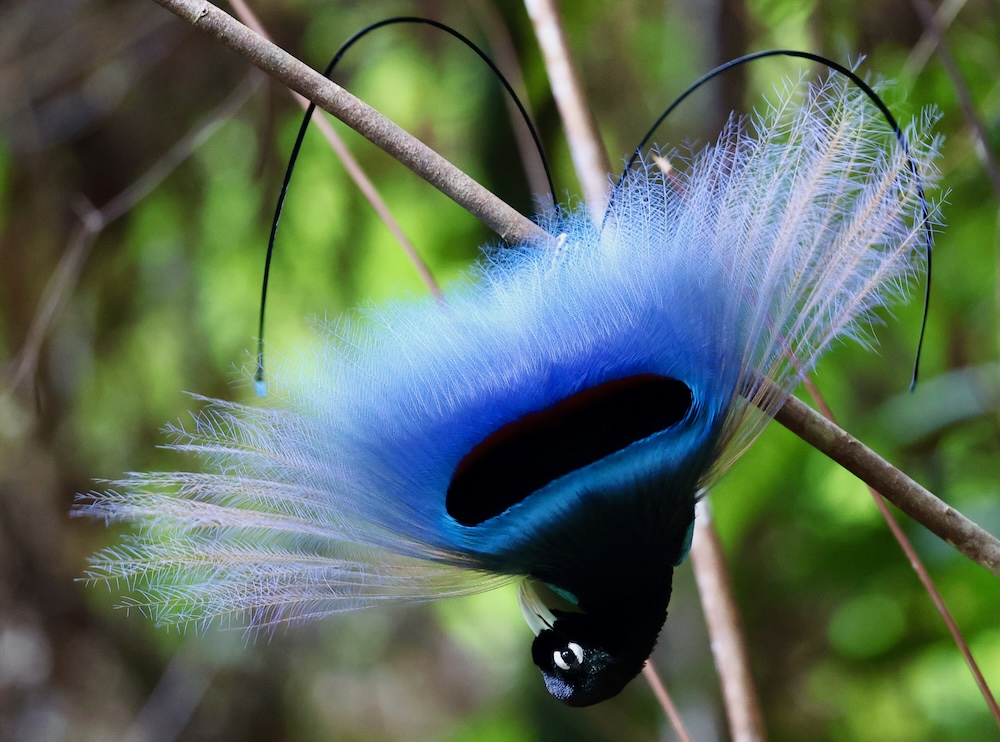
Displaying Blue Bird-of-Paradise Paradisaea rudolphi – ©Bird-Photo-Tours ASIA
New Guinea has more than 400 endemic bird species (including offshore islands), although the relatively arbitrary international boundary that bisects the main landmass means that mainland Papua New Guinea supports a mere 25 or so true endemics. However these include some astonishingly beautiful species such as Fire-maned Bowerbird, Brown-headed Paradise Kingfisher, Ribbon-tailed Astrapia, and Raggiana, Emperor and Blue Birds of Paradise.
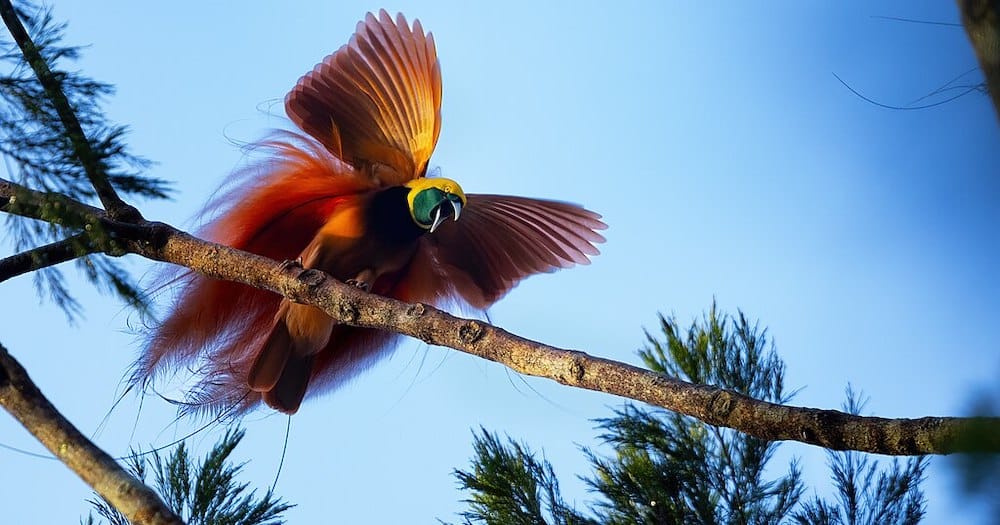
Raggiana Bird-of-paradise, Varirata National Park – ©Creative Commons Attribution-Share Alike 4.0 International
A three to four week trip to the top sites in Papua New Guinea (see below) could produce a total of around 300 species, but more intrepid birders with more time will find many other excellent sites just waiting to be discovered.
-
Kiunga
InformationSatellite ViewKiunga is a lowland rainforest area in the west of the country near the Irian Jaya border, possible birds include, Southern Crowned Pigeon, Pesquet's Parrot, Blue Jewel Babbler, Palm Cockatoo, Common Paradise Kingfisher, Flame Bowerbird, Twelve-wired, Greater, Raggiana and King Birds of Paradise. -
Tabubil
InformationSatellite ViewTabubil is a site in the foothills of the Star Mountains which is good for Chestnut-backed Jewel Babbler, Carola's Parotia and Magnificent Bird of Paradise. -
Tari/Mt. Hagen
InformationSatellite ViewTari/Mt. Hagen are Highland sites from 1700 - 2900 metres above sea level. Many birds including Ribbon-tailed Astrapia, Black and Brown Sicklebills, Lawe's Parotia, Blue, Crested, Superb and King of Saxony Birds of Paradise. -
Varirata National Park
InformationSatellite ViewVarirata National Park is near Port Moresby, highlights could include Dwarf Cassowary, Brown-headed Paradise Kingfisher, Eastern Riflebird and Wallace's Fairy wren.
-
Chris Lodge
https://www.chrislodgeart.com
-
Number of bird species: 876
National Bird - Raggiana Bird of Paradise Paradisaea raggiana
Number of endemics: 113
Pied Cuckoo-dove Reinwardtoena browni
New Britain Bronzewing Henicophaps foersteri
Gray-naped Pheasant-pigeon Otidiphaps cervicalis
Black-naped Pheasant-pigeon Otidiphaps insularis
Scheepmaker's Crowned-pigeon Goura scheepmakeri
Finsch's Imperial-pigeon Ducula finschii
Louisiade Imperial-pigeon Ducula salvadorii
Bismarck Imperial-pigeon Ducula melanochroa
Yellowish Imperial-pigeon Ducula subflavescens
Knob-billed Fruit-dove Ptilinopus insolitus
Pied Coucal Centropus ateralbus
Violaceous Coucal Centropus violaceus
Bougainville Rail Hypotaenidia tertia
Golden Masked-owl Tyto aurantia
Manus Boobook Ninox meeki
New Britain Boobook Ninox odiosa
Manus Boobook Ninox variegata
Black Honey-buzzard Henicopernis infuscatus
New Britain Goshawk Accipiter princeps
Slaty-backed Goshawk Accipiter luteoschistaceus
New Britain Sparrowhaw Accipiter brachyurus
Manus Dwarf-kingfisher Ceyx dispar
New Ireland Dwarf-kingfisher Ceyx mulcatu
New Britain Dwarf-kingfisher Ceyx sacerdotis
Bismarck Kingfisher Ceyx websteri
Bougainville Moustached Kingfisher Actenoides bougainvillei
New Britain Kingfisher Todiramphus albonotatus
Black-headed Paradise-kingfisher Tanysiptera nigriceps
Brown-headed Paradise-kingfisher Tanysiptera danae
Blue-eyed Cockatoo Cacatua ophthalmica
Red-chinned Lorikeet Charmosyna rubrigularis
Purple-bellied Lory Lorius hypoinochrous
White-naped Lory Lorius albidinucha
Creamy-breasted Fig-parrot Cyclopsitta amabilis
Bismarck Hanging-parrot Loriculus tener
Yellow-breasted Pygmy-parrot Micropsitta meeki
Louisiade Pitta Erythropitta meeki
New Britain Pitta Erythropitta gazellae
Tabar Pitta Erythropitta splendida
New Ireland Pitta Erythropitta novaehibernicae
Superb Pitta Pitta superba
Streaked Bowerbird Amblyornis subalaris
Fire-maned Bowerbird Sericulus bakeri
New Britain Friarbird Philemon cockerelli
New Ireland Friarbird Philemon eichhorni
White-naped Friarbird Philemon albitorques
Bismarck Honeyeater Vosea whitemanensis
White-chinned Myzomela Myzomela albigula
Ashy Myzomela Myzomela cineracea
Reddish Myzomela Myzomela erythrina
New Ireland Myzomela Myzomela pulchella
Sclater's Myzomela Myzomela sclateri
Bismarck Black Myzomel Myzomela pammelaena
Black-bellied Myzomela Myzomela erythromela
Long-billed Myzomela Myzomela longirostris
Rufous-backed Honeyeater Ptiloprora guisei
Bougainville Honeyeater Stresemannia bougainvillei
Spangled Honeyeater Melipotes ater
Elegant Honeyeater Microptilotis cinereifrons
Tagula Honeyeater Microptilotis vicina
Long-bearded Honeyeater Melidectes princeps
Huon Honeyeater Melidectes foersteri
Dimorphic Jewel-babbler Ptilorrhoa geislerorum
Bougainville Hooded Whistler Pachycephala richardsi
Brown-backed Whistler Pachycephala modesta
White-bellied Whistler Pachycephala leucogastra
Rossel Cicadabird Edolisoma rostratum
Mussau Triller Lalage conjuncta
Tagula Butcherbird Cracticus louisiadensis
White-backed Woodswallow Artamus insignis
Bismarck Fantail Rhipidura dahli
Mussau Fantail Rhipidura matthiae
Manus Fantail Rhipidura semirubra
Bougainville Fantail Rhipidura drownei
Ribbon-tailed Drongo Dicrurus megarhynchus
Mussau Flycatcher Myiagra hebetior
Velvet Flycatcher Myiagra eichhorni
Djaul Flycatcher Myiagra cervinicolor
Manus Monarch Symposiachrus infelix
White-breasted Monarch Symposiachrus menckei
Black-tailed Monarch Symposiachrus verticalis
Djaul Monarch Symposiachrus ateralbus
Bismarck Crow Corvus insularis
Curl-crested Manucode Manucodia comrii
Wahnes's Parotia Parotia wahnesi
Lawes's Parotia Parotia lawesii
Growling Riflebird Lophorina intercedens
Huon Astrapia Astrapia rothschildi
Stephanie's Astrapia Astrapia stephaniae
Ribbon-tailed Astrapia Astrapia mayeri
Blue Bird-of-paradise Paradisornis rudolphi
Emperor Bird-of-paradise Paradisaea guilielmi
Goldie's Bird-of-paradise Paradisaea decora
Raggiana Bird-of-paradise Paradisaea raggiana
Spotted Berrypecker Rhamphocharis piperata
Yellow Satinbird Cnemophilus macgregorii
New Britain Flyrobin Monachella coultasi
New Britain Thicketbird Megalurulus grosvenori
Bougainville Thicketbird Megalurulus llaneae
Rusty Thicketbird Megalurulus rubiginosus
Odedi Horornis haddeni
Tagula White-eye Zosterops meeki
Bismarck White-eye Zosterops hypoxanthus
Oya Tabu White-eye Zosterops crookshanki
Bougainville White-eye Zosterops hamlini
Louisiade White-eye Zosterops griseotinctus
New Britain Thrush Zoothera talaseae
Bougainville Thrush Zoothera atrigena
Red-banded Flowerpecker Dicaeum eximium
Louisiade Flowerpecker Dicaeum nitidum
Gray-headed Mannikin Lonchura caniceps
New Ireland Mannikin Lonchura forbesi
Alpine Mannikin Lonchura monticola
-
Avibase
PDF ChecklistThis checklist includes all bird species found in Papua New Guinea , based on the best information available at this time. It is based on a wide variety of sources that I collated over many years. I am pleased to offer these checklists as a service to birdwatchers. If you find any error, please do not hesitate to report them. -
Wikipedia
Annotated ListThis is a list of the bird species recorded in Papua New Guinea. The avifauna of Papua New Guinea include a total of 897 species, of which 108 are endemic, and 2 have been introduced by humans. 44 species are globally threatened. -
eBird
PDF ChecklistThis checklist is generated with data from eBird (ebird.org), a global database of bird sightings from birders like you. If you enjoy this checklist, please consider contributing your sightings to eBird. It is 100% free to take part, and your observations will help support birders, researchers, and conservationists worldwide.
-
Birds of New Guinea
| By Bruce Beehler & Thane Pratt | Princeton University Press | 2014 | Paperback | 528 pages, 110 plates with colour illustrations; 1 b/w illustrations, 635 colour distribution | ISBN: 9780691095639 Buy this book from NHBS.com -
Birds of New Guinea: Distribution, Taxonomy, and Systematics
| By Bruce M Beehler & Thane K Pratt | Princeton University Press | 2016 | Hardback | 668 pages, 2 plates with 14 colour photos; 2 b/w maps, tables | ISBN: 9780691164243 Buy this book from NHBS.com -
Birds of New Guinea: Including Bismarck Archipelago and Bougainville
| By Phil Gregory | Lynx Edicions | 2017 | Hardback | 464 pages, 1780+ colour illustrations, 867 colour distribution maps | ISBN: 9788494189272 Buy this book from NHBS.com -
Papua New Guinea Birds
| By Roy D MacKay | University of Papua New Guinea Press | 2012 | Paperback | 36 pages, 72 colour photos, 1 b/w map | ISBN: 9789980945808 Buy this book from NHBS.com
-
New Guinea Binatang Research Center
WebsiteThe Ornithology section at New Guinea Binatang Research Center has a primary duty to conduct field-based research of Birds of Papua New Guinea to address knowledge gaps and conservation of the avifauna in the beautiful nation of Papua New Guinea.
-
*List of protected areas of Papua New Guinea
InformationSatellite ViewIncluded in the PNG protected area list, but not formally recognized by International Union for the Conservation of Nature and Natural Resources (IUCN) is the terrestrial Wildlife Management Area (WMA).[4] WMA is an Integrated Conservation and Development Project (ICAD),[5] which seeks to conserve biological diversity by involving landowners. The idea behind the project is that income generating activities, from the biological diversity would encourage people living in these areas to conserve, because such projects would link the value of these resources to living standard and also access to markets. The progress of WMA's is yet to be evaluated. -
NP Jimi Valley
InformationSatellite View -
NP Mount Wilhelm
InformationSatellite Viewthe highest mountain in Papua New Guinea at 4,509 metres (14,793 ft). It is part of the Bismarck Range and the peak is the point where three provinces, Chimbu, Jiwaka and Madang, meet. -
PP Mount Gahavisuka National Park
Observatory WebsiteSatellite View…noted for the famed birds of paradise, Mt. Wilhelm (4,509) metres), the Asaro Mudmen village, Kainantu pottery, and Dualo Pass - one of the highest road access points in Papua New Guinea - are just a few of the select tours… -
WMA Crater Mountain Wildlife Management Area
InformationSatellite ViewThe Crater Mountain Wildlife Management Area is the perfect destination for those wanting to experience magnificent rainforests while learning more about the traditional lifestyles of the people who call the rainforest home. -
Waigeo & Batanta
InformationSatellite ViewWaitanta’s prolonged isolation produced nearly mythical, endemic feathered life forms as Bruijn’s Brush-turkey Aepypodius bruijnii, Wilson's Cicinnurus respublica and Red Bird of Paradise Paradisaea rubra, one by one species that make the hearts of ornithologists and birders alike beat faster. In fact, every self-respecting world birder is bound to at least once in a lifetime undertake the pilgrimage to the avian delights of Waitanta… -
Wopkola Rainforest
WebsiteSatellite ViewThe project has two development priorities: eco-forestry (reforestation) and nature conservation. Reforestation involves the buying of massive sums of tree seedlings and planting them in customary lands inside Kokop Village. The conservation aspect involves the revival and restoration of the once-destroyed “Wopkola Rainforest” inside Kokop Village, and the declaration of this 30 plus hectare site as an indefinite ‘strict conservation zone’.
-
Bird Photo Tours ASIA
Tour OperatorThe island of New Guinea is surely one of the world’s outstanding bird photography locations being home to the “otherworldly” Birds-of-Paradise and with a supporting cast of birds that includes Owlet-Nightjars, Bowerbirds, Frogmouths, Owls, Monarchs, Fruit-Doves, Kingfishers, Honeyeaters, Pittas and Parrots, this Bird-Photo-Tour to Papua New Guinea has so much to offer the bird photographer. -
BirdQuest
Tour OperatorBirdQuest offer several itineraries for Papua New Guinea usually running in July & August -
Birding Ecotours
Tour OperatorPapua New Guinea (PNG) is indeed a birder’s paradise. Thirty-four birds-of-paradise live on the island of New Guinea, of which thirty-one can be found in Papua New Guinea. The island of New Guinea is home to an incredible 399 endemics! Together with awe-inspiring scenery, endless rainforests, and fascinating highland societies that only made contact with the outside world in 1930, this makes Papua New Guinea a definite must-do destination for any avid birder. -
Bluetail Birding
Tour OperatorA 19-day, small group tour that explores the incredible birdlife of Papua New Guinea, looking for birds-of-paradise and more in the extensive lowland and montane forests of one of the most exciting birding destinations anywhere on earth. -
Fieldguides
Tour OperatorBirds-of-paradise and bowerbirds are the crowning jewels of one of most remarkable bird faunas, set against a fascinating cultural backdrop far removed from our own. Survey tour focusing on forest specialties in diverse and scenic regions -
Naturalist Journeys
Tour Operator... Over 700 species of birds have been identified here so far, including around 580 land and freshwater species, 40 sea birds, and 90 migrants from countries to the North and South... -
NatureTrek
Tour OperatorAn exciting 19-day adventure to the lush forests of West Papua in search of its incredible birdlife within the Arfak Mountains, Nimbokrang and Waigeo, with the possibility of up to 17 species of birds-of-paradise. -
Ornis Birding Expeditions
Tour Operator...It is impossible to forget the first time you see a Western Parotia dance, a Black Sicklebill transforming at dawn, or a Wilson’s Bird-of-paradise glowing like fire in the dark forest understory... -
Papua Expeditions
Local Tour OperatorThink huge, man-sized yet infuriatingly wary, flightless cassowaries. Retiring megapodes with fascinating incubation strategies, adeptly manipulating environmental heat sources. A New Guinea Eagle Harpyopsis novaeguineae delivering its remarkable and far-carrying advertising call towards dusk. Or crowned-pigeons abruptly breaking the relative silence when exploding in clapping wingbeats from alongside a creek at noon. Think of the profusion of parrots in all colors and sizes simply imaginable. Dazzling kingfishers, that include three single-island endemic paradise-kingfishers, and the widespread though rarely seen, aptly-named Shovel-billed Kookaburra Clytoceyx rex. Think mysterious nocturnal owlet-nightjars featuring cuddly, feline faces. Glorious jewel-babblers skulking on the forest floor as if most reluctant to reveal their colors. Think utterly astonishing bowerbirds -
Rockjumper Birding Tours
Tour OperatorOver the years we have established an unbeatable reputation for leading highly successful tours to Papua New Guinea, and our tour totals of around 400 species include up to 24 different birds-of-paradise and almost 20 kingfisher species, a feat impossible to match anywhere else! We also offer an extension to New Britain to search for a plethora of endemic doves, kingfishers and parrots. -
Sicklebill Safaris
WebsiteWe also currently run tours to the following international destinations, Papua New Guinea -
Sultan Tours
Tour OperatorSultan Birding is the Wildlife Photography Tour Company in Indonesia that offers different photography tours and trips catering for the beginner to the photography expert.... -
Travelling Naturalist
Tour OperatorOn this trip to Papua New Guinea we discover the startling contrasts of a land whose immense tracts of rainforest and rivers are overlooked by mountains that soar to over 4,500 metres. -
Trek-Papua
Local Tour OperatorOur Birding Tour West Papua will begin in the town of Manokwari, situated on the north-eastern tip of New Guinea’s Bird’s Head, or “Vogelkop”, Peninsula. From here we will travel straight through for five nights in the nearby Arfak Mountains, where we will search for a fabulous series of birds, renowned in birders’ circles as the “Vogelkop endemics”. -
Tropical Birding Tours
Tour OperatorThe island of New Guinea has long been held with fascination among birders, for it holds the majority of arguably the world’s most dramatic bird family: the birds-of-paradise... -
VENTBird
Tour OperatorExceptional tropical forest birding with large numbers of endemics in one of the world’s most exotic birding destinations... -
Ventbird
Tour OperatorOn my last VENT tour, I found four species of birds that would be new for my great friend, David Bishop, whose ornithological explorations in this fascinating country are famous -
WINGS
Tour OperatorThe island of New Guinea is surely one of the most exciting birding destinations on Earth. -
Wise Birding Holidays
Tour OperatorTarget Species Birds: Magnificent, Twelve-wired, Lesser, King, Red, Magnificent and Wilson’s Birds-of-Paradise, Black Sicklebill, Pale-billed Sicklebill, Arfak Honeyeater, Magnificent Riflebird... -
Zoothera Birding
Tour Operator... It is host to an astonishing degree of endemism with a variety of habitats ranging from some of the largest areas of original, intact forest on the planet, lowland swamp forests and alpine grassland where very few birders have had the privilege to explore this amazing area...
-
2016 [08 August] - Wayne Jones
PDF Report..frustratingly shyGrowling Riflebirds and Papuan King Parrots- a lucky few at the front of the queue managedglimpses of a Pheasant Pigeon as it flushedfrom the path. The group had better luck withBrown-headed Paradise Kingfisher, anothernotoriously reticent species, which thankfullyallowed everyone super views. Other birdsalong the trails included Yellow-bellied andFairy Gerygones, Black Berrypecker, RustyMouse-Warbler, Chestnut-bellied Fantail,Mimic Honeyeater, Hooded Butcherbird,Black, Spot-winged and Frilled Monarchs, endearing White-faced Robin, Zoe’s Imperial Pigeon, RustyPitohui, Black Cicadabird, Grey Whistler and Wompoo Fruit Dove. -
2016 [09 September] - Adam Walleyn
PDF Report...We then had alook at the bower of a Fawn-breasted Bowerbird,before moving on to the ponds area. As usual,there was a multitude of waterbirds present,including Plumed and Wandering WhistlingDucks, Pacific Black Ducks, Little Pied andLittle Black Cormorant, Australasian LittleGrebe, Australian White Ibis, Australasian Swamphen, Dusky Moorhen, Comb-crested Jacana andeven 2 Pacific Golden Plovers.... -
2016 [09 September] - Adam Walleyn - New Britain
PDF Report...A pleasant assortment of birds sat out on bare branchesin the early morning light: Variable Goshawks, Red-knobbed Imperial Pigeon, numerous EclectusParrots, Purple-bellied Lories, Red-flanked Lorikeets, White-necked Coucals, Moustached Treeswift,Blyth’s Hornbills, Long-tailed Mynas and Metallic Starlings.... -
2016 [11 November] - Jay VanderGaast & Doug Gchfeld - New Guinea & Australia
Report...We started things off with an afternoon visit to PAU, where, among many other species, we enjoyed great looks at dapper Pied Herons, a trio of massive Papuan Frogmouths, raucous Yellow-faced Mynas, and at day's end, unbeatable views of a scarce Black Bittern. Our visits to nearby Varirata National Park were equally productive, as among expected standouts such as Raggiana BoP, Brown-headed Paradise-Kingfisher, Yellow-billed Kingfisher, Barred Owlet-Nightjar, Frilled Monarch, and Hooded PItohui there were also some wonderful surprises in the forms of Dwarf Koel, Hooded Pitta, and Buff-breasted Paradise-Kingfisher, all three of which allowed us lengthy scope studies! Fruit-doves were also memorable here, with Pink-spotted, Orange-bellied, the tiny Dwarf, and the beautiful Beautiful fruit-doves all giving excellent views... -
2017 [09 September] - Gareth Robbins - New Brittain
PDF Report...We then continued to another section of the plantations and birded next to the Kulu River,wherewesaw Blythe’s Hornbill, Long-tailed Myna and a couple of Red-knobbed Imperial Pigeons. Further ahead of us was a large pool of water,and we made a brief stop here to see some White-browed Crakes after hearing them call within the surrounding areas. -
2017 [10 October] - Jay VanderGaast
Report...Birding began in the Port Moresby region, with a stop at PAU starting things off nice and easy with a good assortment of waterbirds (including Rufous Night-Heron and Pied Heron) and a small selection of endemics like the lovely Orange-fronted Fruit-Dove, White-shouldered Fairywrens, and Yellow-faced Myna among them. Things got even more serious the next morning with our first visit to the wonderful Varirata NP. Among many excellent sightings there, standouts included a remarkably unwary Yellow-legged Brush-Turkey (first I've seen in the park!), striking Pacific Bazas, several scarce Purple-tailed Imperial-Pigeons, two species of paradise-kingfishers, and Raggiana Bird-of-Paradise. -
2017 [11 November] - Jay VanderGaast - New Guinea & Australia
ReportI'm not sure what factors were at play at Varirata on our first visit there, but for me, this tour will always be memorable for "the day of the kingfisher", when we tallied great views of 8 different species of these incredible birds! The park is always great for these birds, with regulars like Brown-headed Paradise-Kingfisher, Rufous-bellied Kookaburra, and Yellow-billed Kingfisher all having high "wow!" factors. -
2018 [06 June] - Dani Lopez Velasco
PDF ReportOur first tour to Papua New Guinea –including New Britain- in 2018 was a great success and delivered a high number of quality birds. A total of 21 species of Birds-of-paradise (BoPs) - undoubtedly one of the most extraordinary, and “out of this world” bird families in the world-, were recorded, perhaps most memorable being a superb male Blue BoP, seen at close range near Kumul for as long as we wished. Just as impressive though were spectacular performances by displaying Raggiana and Greater BoPs in excellent light, stunning males King and Twelve-wired BoPs in the Kiunga area, a cracking adult male Growling Riflebird at Varirata, several amazing King-of-Saxony BoPs, waving their incredible head plumes like some strange insect antennae in the mossy forest of Tari Valley, great sightings of both Princess Stephanie´s and Ribbon-tailed Astrapias with their ridiculously long tail feathers, superb scope studies of Black –doing full display!- and Brown Sicklebills, uttering their machine-gun like calls, and so on. -
2019 [09 September] - Stephan Lorenz
PDF ReportPapua New Guinea's birding allure stems from its diversity of birds-of-paradise and several fascinating, ancient bird families, of which seven are restricted to the island -
2019 [10 October] - Jay VanderGaast
Report... But getting out of the city, it was a different story, and soon we were marveling at such birds as a very cryptic Papuan Frogmouth at PAU, and fantastically-plumed Raggiana Birds-of-Paradise at their display area in Varirata... -
2019 [12 December] - Dominic Chaplin - Isurava, Kokoda Track, Papua New Guinea
PDF ReportDepending on your point of view, there are five SE New Guinea endemics in the Owen Stanley Range that are very difficult to access. These can all be accessed via the Kokoda Trail with a moderate/severe degree of effort... -
2023 [08 August] - Andrew Walker
PDF ReportWe recorded 21 species of astonishing birds-of-paradise: Splendid Astrapia, Princess Stephanie’s Astrapia, Ribbon-tailed Astrapia, King of Saxony Bird-of-paradise, Queen Carola’s Parotia, Short-tailed Paradigalla, Black Sicklebill, Brown Sicklebill, Black-billed Sicklebill, Glossy-mantled Manucode, Trumpet Manucode, Crinkle-collared Manucode, Magnificent Riflebird, Growling Riflebird, Greater Lophorina, King Bird-of-paradise, Magnificent Bird-of-paradise, Twelve-wired Bird-of-paradise, Greater Bird-of-paradise, Raggiana Bird-of-paradise, and Blue Bird-of-paradise. -
2023 [08 August] - Andrew Walker - New Britain Extension
PDF ReportThe list of highlights was very long and included Melanesian Megapode, Red-knobbed Imperial Pigeon, Yellowish Imperial Pigeon, Island Imperial Pigeon, Finsch’s Imperial Pigeon, Nicobar Pigeon, Knob-billed Fruit Dove, MacKinlay’s Cuckoo-Dove, Blue-eyed Cockatoo, Singing Parrot, Purple-bellied Lory, Bismarck Hanging Parrot, Buff-faced Pygmy Parrot, White-necked Coucal, Violaceous Coucal, Blyth’s Hornbill, Golden Masked Owl, New Britain Boobook, Black-capped Paradise Kingfisher, New Britain Dwarf Kingfisher, White-mantled Kingfisher, Melanesian Kingfisher, Beach Kingfisher, Bismarck Pitta (New Britain Pitta), Bismarck Crow, Spangled (Bismarck) Drongo, New Britain Friarbird, Sclater’s Myzomela, Black-bellied Myzomela, Ashy Myzomela, Black-tailed Monarch, Velvet Flycatcher, Long-tailed Myna, Red-banded Flowerpecker, and Buff-bellied Mannikin. Two Wood Sandpipers in a flooded field were a surprise find and were vagrants to New Britain. -
2023 [10 October] - Joshua Bergmark
PDF Report...Some eager birders were ushered straight from their arriving international flight into a waiting helicopter, which whisked us over the foothills of the Owen-Stanley range and landed at the remote Kokoda Track village of Kagi by 8:30am... -
2024 [06 June] - Joshua Bergmark
PDF Report...After making necessary arrangements with the village head, we hiked into the forest. It took some persistence after three false starts with display areas only attended by young males, but eventually we luckedout and found a really active tree with three stunning adult Goldie’s Bird-of-paradise carrying-on and dancing right in front of us... -
2024 [07 July] - Angus McNab
PDF ReportThe eBird list was compiled by client Greg Butcher and does include an early day in Australia. -
2024 [10 October] - Joshua Bergmark
PDF Report...We then rediscovered Bougainville Thicketbird (lost for 21 years), again taking the first ever photos in the wild and sound recordings. Unfortunately our rediscovery of the similarly lost Bougainville Thrush was a heard only! -
2025 [06 June] - Bird-Photo-Tours
ReportThis trip report showcases many of the portraits from our Papua New Guinea 2025 Bird-Photo-Tour covering 8 provinces in total including 6 provinces on New Guinea itself plus two provinces in the Bismarck Archipelago.
-
Bird of Paradise Hotel - Goroka
Trip AdvisorThe untouched beauty of the Eastern Highlands Province is the setting for the Bird of Paradise Hotel where luxury, style and impeccable service await you. The hotel`s central location in Goroka provides easy access to every modern facility, yet only a short drive away is the timeless village of the Asaro Mudmen. -
Wilderness Lodges of PNG
AccommodationAn inspired mixture of local architecture, spectacular views and modest luxury off the beaten track. Located at 7000 feet (2100 meters) in the PNG Southern Highlands, homeland of the Huli clan with their human hair wigs adorned with colorful flowers…
-
Kiunga
WebsiteKiunga is a small river port sited on the upper reaches of the Fly River in the remote Western Province of Papua New Guinea. It is surrounded by vast tracts of swamp forest and lowland rain forest, and one thing that has become clear over recent years is just how good the area is; a sort of lowland equivalent of Ambua for species diversity. When we first started going there in 1991, there were 7 really special birds that we were particularly looking for: Southern Crowned Pigeon (one of the world`s most incredible species); Flame Bowerbird, New Guinea Flightless Rail, Large Fig-Parrot, Little Paradise-Kingfisher, White-bellied Pitohui and Yellow-eyed Starling. -
Papua New Guinea Birds
InformationNew Guinea birds with their brilliant colour, surpass those of any other country. Beautiful Birds of Paradise (the country's emblem); and wonderful dances of the flag-birds and others. There are 650 species, within 75 families. -
Victoria Crowned Pigeon Goura victoria
InformationCrowned pigeons are larger than all other pigeons. They are mainly distributed throughout New Guinea. These particular pigeons receive their name from the lacy feathers on their heads. They rank among some of the prettiest and brightest pigeons. Usually it they are hunted for plumage


